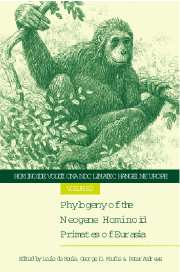 Hominoid Evolution and Climatic Change in Europe
Hominoid Evolution and Climatic Change in Europe Book contents
- Frontmatter
- Contents
- List of Contributors
- Acknowledgements: The European Science Foundation
- PART I: Chronology and environment
- PART II: Methods and phylogeny
- 3 Computer-assisted morphometry of hominoid fossils: the role of morphometric maps
- 4 Comparative analysis of the iliac trabecular architecture in extant and fossil primates by means of digital image processing techniques: implications for the reconstruction of fossil locomotor behaviours
- 5 Dental microwear and diet in Eurasian Miocene catarrhines
- 6 How reliable are current estimates of fossil catarrhine phylogeny? An assessment using extant great apes and Old World monkeys
- 7 Cranial discrete variation in the great apes: new prospects in palaeoprimatology
- PART III Miocone hominoids: function and phylogeny
- Index
7 - Cranial discrete variation in the great apes: new prospects in palaeoprimatology
from PART II: Methods and phylogeny
Published online by Cambridge University Press: 06 January 2010
- Frontmatter
- Contents
- List of Contributors
- Acknowledgements: The European Science Foundation
- PART I: Chronology and environment
- PART II: Methods and phylogeny
- 3 Computer-assisted morphometry of hominoid fossils: the role of morphometric maps
- 4 Comparative analysis of the iliac trabecular architecture in extant and fossil primates by means of digital image processing techniques: implications for the reconstruction of fossil locomotor behaviours
- 5 Dental microwear and diet in Eurasian Miocene catarrhines
- 6 How reliable are current estimates of fossil catarrhine phylogeny? An assessment using extant great apes and Old World monkeys
- 7 Cranial discrete variation in the great apes: new prospects in palaeoprimatology
- PART III Miocone hominoids: function and phylogeny
- Index
Summary
Distinguishing them from other morphological traits, the scoring methods for which are affected by major drawbacks, this chapter illustrates and defines, precisely, 19 cranial discrete traits in extant great apes and discusses their benefit for palaeoprimatological studies. An increasing number of genetic data demonstrates that the patterning of intraspecific variation among the great apes is more complex than previously thought. This study begins with an adequate sampling of the subspecies being analysed. Thereafter, using a database of 1453 individuals, the geographic variation of extant great apes is discussed and graphically illustrated for chimpanzees (Pan spp), for the five age categories distinguished, using appropriate statistical tools. The results bring to light the developmental patterns evidenced from discrete trait studies as well as the underestimate of skeletal variation due to both inadequate sampling and incomplete osteological studies. Solving these two important problems may confound the highly debated issues of early hominid, Neogene hominoid species recognition and inferences about their phylogenetic relationships and palaeobiology. In this connection, the following quote (Shea et al., 1993: p. 289) exactly reflects the underlying philosophical basis for this study:
In sum, we propose that paleoanthropology would benefit tremendously if a great deal more extensive background work were undertaken on the patterns of variation in the relevant qualitative or quantitative features, before species groupings were determined, character states delimited, polarities estimated, and phylogenies reconstructed. This would probably greatly reduce or clarify the number of equally parsimonious phylogenies, the requisite frequency of homoplasy, and the debates over basic units of analysis.
- Type
- Chapter
- Information
- Hominoid Evolution and Climatic Change in EuropePhylogeny of the Neogene Hominoid Primates of Eurasia, pp. 151 - 190Publisher: Cambridge University PressPrint publication year: 2001
- 1
- Cited by
